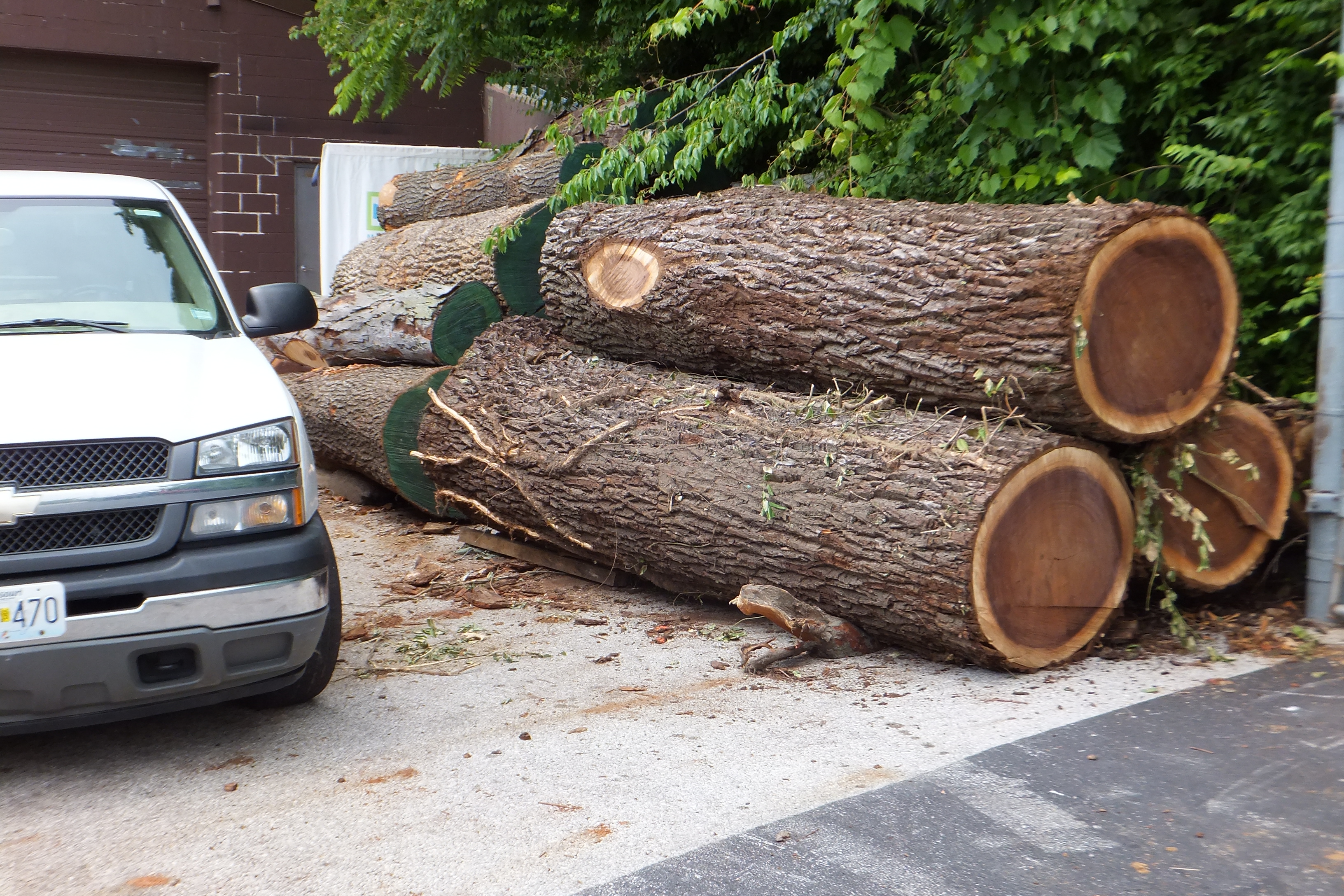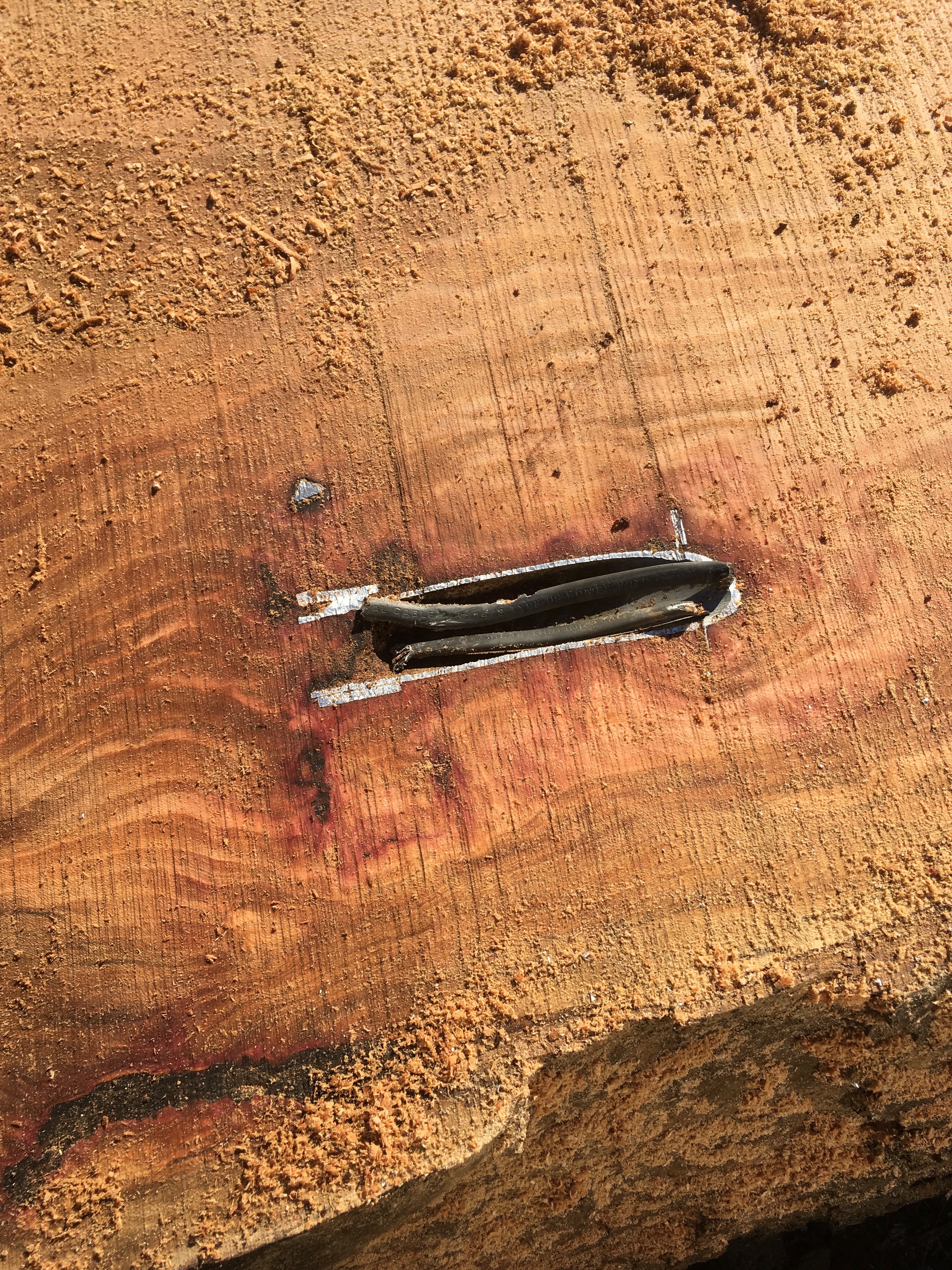Author
By Scott Wunder



 This is a good-looking walnut log, but it has a lot of sapwood (white ring on the outside), which will make it less valuable. If you don’t sell logs regularly, there is no way you would know that this could be an issue for some buyers.
This is a good-looking walnut log, but it has a lot of sapwood (white ring on the outside), which will make it less valuable. If you don’t sell logs regularly, there is no way you would know that this could be an issue for some buyers.



https://www.woodworkingnetwork.com/wood/pricing-supply/how-much-your-log-worth
By Scott Wunder
The short answer is probably not as much as you had hoped, but you’re not here for the short answer, so I’ll give you the long one.
First off, you need a bit of background of where I come from on this subject. I mill, sell and work with lumber from mostly suburban settings with lots of yard trees salvaged from tree services and a decent number of logs from wooded settings, usually where a building is about to be erected. This means my log supply can range from barely usable to awesomely perfect and all with lots of wacky and wild in between. I normally pay nothing for my logs and only buy a couple of logs per year, which I just can’t live without. I mostly don’t pay for logs because I mostly don’t have to. There are lots of logs available to me, especially if I am willing to pick them up.
Since I work in an area with a large population (St. Louis and St. Charles, MO), I often get requests from homeowners looking to make money from their logs, especially after hearing age-old stories of walnut logs selling for thousands and thousands of dollars. These consistent requests and a recent article in the Missouri Conservationist magazine (click here to read the article) about Missouri hardwoods prompted me to put into writing what I have repeated probably hundreds of times.
A log is worth as much as someone is willing to pay. This sounds like a smartass answer, but it isn’t. If you don’t know where to sell your logs or you can’t find someone in your area willing to pay, they aren’t worth much. And, if you can’t get your logs to the buyer they are worth even less. Especially, if you only have one tree, expect no excitement from someone who normally purchases logs. You won’t get a larger purchaser, like a big sawmill, to come out for less than a truckload.
Your log probably isn’t as great as you think it is. You would be amazed by how many people call me and tell me about a walnut tree in their yard that is at least 40 years old or about the tree which has its first branch at 5′ from the ground. A walnut tree is a baby at 40 years old and is obviously a short, branchy yard tree with not much of a log if there are branches 5′ from the ground. A good tree, one worth really talking about, will have at least 10′ of branchless trunk, if not 14′ or 16′ or more. Just because it is a walnut tree, doesn’t mean it is a good walnut tree.

This walnut tree was about 90 years old and produced a very nice stem. The bottom log has about 250 bf. in it and would fetch about $500 dollars delivered to a sawmill. The top log in the pile and the second log up in the tree has about 200 bf. in it and would be worth about $175.
Most high-dollar logs are veneer-quality logs. Almost all of the stories of logs selling for high prices are for veneer-quality logs. And, almost all of the logs out there are not veneer-quality logs. Veneer logs look like they came from the “log factory” and are perfect in every way; no signs of knots, straight, round, good color, good growth ring spacing, centered pith, no bird peck, no shake, no metal, fresh, and hopefully, big. I only get a few veneer quality trees out of hundreds per year and they almost never come out of yards. They are usually hidden somewhere in the woods.

White oak logs don’t get much better than this 16′ long x 30″ diameter example. Yet, the veneer buyer wasn’t interested in purchasing it because the color was not good.
Yard trees have metal in them. This is no myth. Whether you remember doing it or not, there is a good chance your yard tree has metal in it. Metal, like nails, hooks, wires and chains mess up saw blades and make a mess by staining the wood. I expect trees I pick up to have metal in them, and I will work around it, but remember, I don’t pay for trees. Larger operations have no reason to buy logs with metal in them, especially if the next log truck in the gate is full of logs without metal.

Bottom logs have the most valuable wood and the most metal, like this electrical conduit with wires.
You don’t know what you don’t know. If you are reading this, it is most likely because you don’t sell logs on a regular basis (or, you just want to see if I know what I am talking about). Without doing this consistently, you can’t know enough about your logs to properly sell them. You can’t get it in front of the right people at the right time and present them with something they can’t live without, and you definitely can’t defend your product. You will be at the mercy of the buyer. They will know after the first thing out of your mouth that you do not know what you are doing, and even if they are fair, they will never overpay.
 This is a good-looking walnut log, but it has a lot of sapwood (white ring on the outside), which will make it less valuable. If you don’t sell logs regularly, there is no way you would know that this could be an issue for some buyers.
This is a good-looking walnut log, but it has a lot of sapwood (white ring on the outside), which will make it less valuable. If you don’t sell logs regularly, there is no way you would know that this could be an issue for some buyers.
You can tell from most of these points that I am pretty sure you aren’t going to get rich from your single tree or a couple of logs (especially from me) and you shouldn’t expect to. With that point made, you should know that some do have value if you have a place to sell them and you have a way to get them to a buyer. So, if I haven’t completely dissuaded you from selling your logs, below are some pricing examples that you can expect if you were to sell your logs to a larger operation in the Midwest:
Average price, based on 20″ diameter inside the bark on the skinny end x 10′ long = 160 bf.
Red oak $.70 per bf. clear saw log = $112, $1.00 per bf. veneer log= $160
White oak $.85 per bf. clear saw log = $136, $1.50 per bf. veneer log= $240
Walnut $1.70 per bf. clear saw log = $272, $3.50 per bf. veneer log= $560
Cherry $.90 per bf. clear saw log = $144, $1.40 per bf. veneer log= $224
Hard Maple $.75 per bf. clear saw log = $120, $1.25 per bf. veneer log= $200

This mix of 10′ x 20″ black oak, white oak and post oak trees from a homebuilding site would sell for about $75-$100 each, delivered to a local sawmill.
Now, obviously prices will range from mill to mill, based on what wood is available in the area, what is selling well and if the mill specializes in any products or species. The above prices should just serve as a guidepost in determining if bothering to sell your logs is worthwhile. Most of the logs in the pricing example above would not cover the price of trucking on their own, so marketing one log most likely doesn’t make sense, unless you can haul it yourself.
However, you can see that if a landowner were to have a large number of trees, the money could start to add up. $112 for a red oak log doesn’t sound like much, but it starts to sound like something when there is a semi truckload of $112 logs. This is what most large timber sales are based on; a large number of logs sold at a fair price and not necessarily getting rich on one tree.
Usually, the phone calls I answer are about a single “big” walnut tree which will cost a homeowner lots of money to remove because it is large and right up against the house. They see a big log worth big money. However, the removal costs also jump up with the increase in tree size, negating any benefit of a larger tree. Their hope is that I will be excited enough about their tree to cut it down (safely, I presume) in trade for the wood, but the math doesn’t work out. A tree which costs $3,000 to remove probably won’t have $3,000 worth of logs in it, no matter if it is walnut or not.
Remember, the bottom line is that logs do have some value, but if you can’t do all of the work like cutting, hauling and selling yourself there is almost no way to make money on a single tree. Unless, of course, you just happen to have a tree like the ones below that I couldn’t live without.

This 11′ x 42″ diameter walnut took two forklifts to move and was one of only two trees which I purchased last year. I paid $950 for this log and it is the largest walnut I have personally processed. This log is potentially worth more money, but it had several obvious signs of metal, so larger mills weren’t interested.

This 15′ x 38″ diameter walnut was the second of only two trees which I purchased within the last year. I paid $700 for the tree and it is the second largest walnut I have ever cut. This tree also had metal in it, which kept the price down.
For further information log on website :https://www.woodworkingnetwork.com/wood/pricing-supply/how-much-your-log-worth





No comments:
Post a Comment